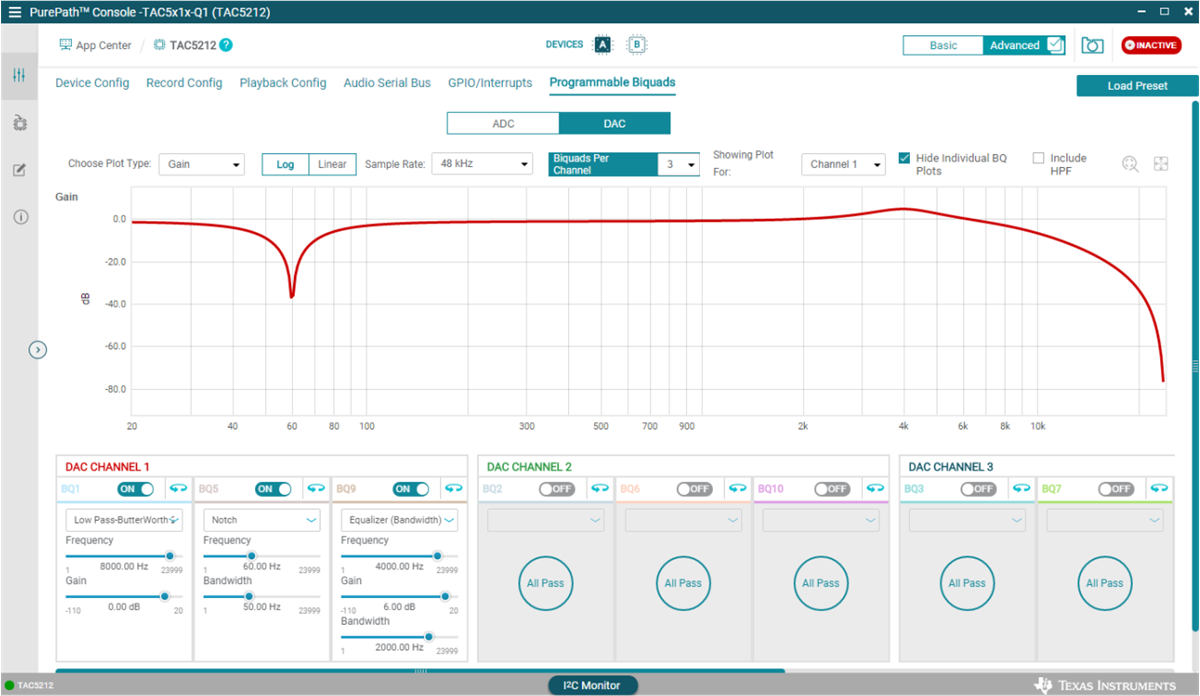SLAAEH6 September 2024 TAA5212 , TAA5412-Q1 , TAC5111 , TAC5111-Q1 , TAC5112 , TAC5211 , TAC5212 , TAC5212-Q1 , TAC5311-Q1 , TAC5312-Q1 , TAC5411-Q1 , TAC5412-Q1 , TAD5112 , TAD5112-Q1 , TAD5212 , TAD5212-Q1
- 1
- Abstract
- Trademarks
- 1Introduction
- 2Infinite Impulse Response Filters
-
3TAC5x1x and TAC5x1x-Q1 Digital Biquad
Filters
- 3.1 Filter Design using PurePath™ Console
- 3.2 Generating Coefficients N0, N1, N2, D1, D2 using a Digital Filter Design Package
- 3.3 Avoiding Overflow Conditions
- 3.4 Biquad Filter Allocation on Recording Channel
- 3.5 Biquad Filter Allocation on Playback Channel
- 3.6 Biquad Filter Programming Example on the TAC5x1x
- 4Typical Audio Applications of Biquad Filters
- 5Summary
- 6References
3.6 Biquad Filter Programming Example on the TAC5x1x
Coefficients of Digital Biquad Filters can be implemented by running a command script to send an I2C command to the EVM. The following script segment shows how to program the coefficients for a set of filters for 5dB boost at 500Hz with bandwidth of 400Hz, cut –5dB at 4kHz with 5kHz bandwidth, and a notch filter at 60Hz with 50Hz bandwidth on channel 1 of the recording path, with the frequency response being as shown in Figure 3-3. Here, the filter coefficients are programmed as follows:
- Filter 1: N0 = 0x7FFFFFFF, N1 = 0x85F4B2CB, N2 = 0x749CADCB, D1 = 0x7C77A718, D2 = 0x8687F4EE
- Filter 2: N0 = 0x6B645FE5, N1 = 0xB9ED52C9, N2 = 0x366F3978, D1 = 0x4612AD37, D2 = 0xDE2C66A1
- Filter 3: N0 = 0x7F951DC9, N1 = 0x806BE418, N2 = 0x7F951DC9, D1 = 0x7F941BE8, D2 = 0x80D5C46D
#Select Page 8
w a0 00 08
#Program coefficients N0, N1, N2, D1, D2 of biquad filter 1
w a0 08 7f ff ff ff 85 f4 b2 cb 74 9c ad cb 7c 77 a7 18 86 87 f4 ee
#Program coefficients N0, N1, N2, D1, D2 of biquad filter 5
w a0 58 6b 64 5f e5 b9 ed 52 c9 36 6f 39 78 46 12 ad 37 de 2c 66 a1
#Select Page 9
w a0 00 09
#Program coefficients N0, N1, N2, D1, D2 of biquad filter 9
w a0 30 7f 95 1d c9 80 6b e4 18 7f 95 1d c9 7f 94 1b e8 80 d5 c4 6d Similarly, following script segment shows how to program the coefficients for a set of filters including a Low Pass Butterworth at 8kHz, a notch filter at 60Hz with 50Hz bandwidth, and an equalizer that boosts 6dB at 4kHz with a bandwidth of 2kHz on channel 1 of the playback path, with the frequency response being as shown in Figure 3-5. Here, the filter coefficients are programmed as follows:
- Filter 1: N0 = 0x13D8B646, N1 = 0x13D8B646, N2 = 0x13D8B646, D1 = 0x27B16C8C, D2 = 0xE13A4DCD
- Filter 2: N0 = 0x7F951DC9, N1 = 0x806BE418, N2 = 0x7F951DC9, D1 = 0x7F941BE8, D2 = 0x80D5C46D
- Filter 3: N0 = 0x7FFFFFFF, N1 = 0xA81AE64B, N2 = 0x4AFC10C8, D1 = 0x62053997, D2 = 0x9DA1ADE4
#Select Page 15
w a0 00 0f
#Program coefficients N0, N1, N2, D1, D2 of biquad filter 1
w a0 08 13 d8 b6 46 13 d8 b6 46 13 d8 b6 46 27 b1 6c 8c e1 3a 4d cd
#Program coefficients N0, N1, N2, D1, D2 of biquad filter 5
w a0 58 7f 95 1d c9 80 6b e4 18 7f 95 1d c9 7f 94 1b e8 80 d5 c4 6d
#Select Page 16
w a0 00 10
#Program coefficients N0, N1, N2, D1, D2 of biquad filter 9
w a0 30 7f ff ff ff a8 1a e6 4b 4a fc 10 c8 62 05 39 97 9d a1 ad e4 
Figure 3-5 Expected DAC Biquad Filter Response Using the Script